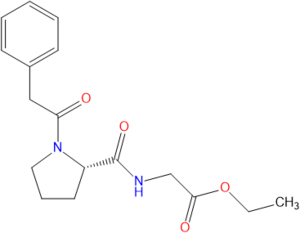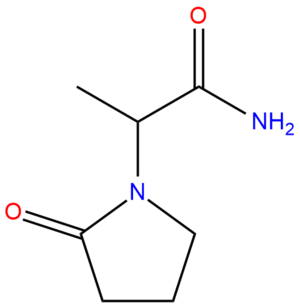Nootropic: Difference between revisions
>Oskykins |
>Oskykins |
||
| Line 10: | Line 10: | ||
==Classes of nootropics== | ==Classes of nootropics== | ||
[[File:Noopept.png|thumbnail|Noopept Molecule]] | |||
There are several classes of nootropics, as well as compounds which fit no specific classification, per se. Once of the most well-known and most-utilized is that of the racetams, the prototypical example being that of piracetam, the first nootropic recognized as such in 1964. | There are several classes of nootropics, as well as compounds which fit no specific classification, per se. Once of the most well-known and most-utilized is that of the racetams, the prototypical example being that of piracetam, the first nootropic recognized as such in 1964. | ||
[[File:Piracetam.png|thumbnail|Piracetam Chemical Structure]] | [[File:Piracetam.png|thumbnail|Piracetam Chemical Structure]] | ||
| Line 15: | Line 16: | ||
A second class of nootropic compounds is that of the synthetic peptides, the most common example being that of Noopept. Although not a racetam, Noopept is commonly grouped with racetams due to a similar mode of action, however, it does not contain a 2-pyrrolidinone moiety, and is strictly not a racetam. | A second class of nootropic compounds is that of the synthetic peptides, the most common example being that of Noopept. Although not a racetam, Noopept is commonly grouped with racetams due to a similar mode of action, however, it does not contain a 2-pyrrolidinone moiety, and is strictly not a racetam. | ||
Due to the fact that nootropics science is in its infancy, there are continually new compounds being synthesized such as IDRA-21, PRL-8-53, Unifiram, Sunifiram, etc. which do not neatly fit into a structural drug class. Additionally, side effects, dosages, dangerous interactions and the like are virtually unknown for some of these compounds, making investigations into their use by the average psychonaut risky. | Due to the fact that nootropics science is in its infancy, there are continually new compounds being synthesized such as IDRA-21, PRL-8-53, Unifiram, Sunifiram, etc. which do not neatly fit into a structural drug class. Additionally, side effects, dosages, dangerous interactions and the like are virtually unknown for some of these compounds, making investigations into their use by the average psychonaut risky. | ||
==Subjective effects== | ==Subjective effects== | ||
Revision as of 02:57, 8 April 2016
Nootropics, also referred to as smart drugs, memory enhancers, neuro enhancers, cognitive enhancers, and intelligence enhancers, are drugs, supplements, nutraceuticals, and functional foods that purportedly improve mental functions such as cognition, memory, intelligence, motivation, attention, and concentration.[1][2] Nootropics are thought to work by altering the availability of the brain's supply of neurochemicals (neurotransmitters, enzymes, and hormones), by improving the brain's oxygen supply, or by stimulating nerve growth.
Proposed criteria
Dr. Giurgea proposed the following criteria for determining whether or not a substance fits the "nootropic" descriptor:
- Enhancement of learning and memory function
- Improvement of learned behaviours when conditions are set to disrupt them (eg. administering an amnesiac)
- Must be neuroprotective
- Must be extremely low in toxicity, with few to no side effects
Thus, according to the strict definition of a nootropic, substances such as amphetamine, methylphenidate, modafinil are not nootropics but are better considered as stimulants and eugeroics.
Classes of nootropics

There are several classes of nootropics, as well as compounds which fit no specific classification, per se. Once of the most well-known and most-utilized is that of the racetams, the prototypical example being that of piracetam, the first nootropic recognized as such in 1964.

The racetams all share a 2-pyrrolidinone cycle. Other racetam nootropics include aniracetam, oxiracetam, phenylpiracetam, and coluracetam.
A second class of nootropic compounds is that of the synthetic peptides, the most common example being that of Noopept. Although not a racetam, Noopept is commonly grouped with racetams due to a similar mode of action, however, it does not contain a 2-pyrrolidinone moiety, and is strictly not a racetam.
Due to the fact that nootropics science is in its infancy, there are continually new compounds being synthesized such as IDRA-21, PRL-8-53, Unifiram, Sunifiram, etc. which do not neatly fit into a structural drug class. Additionally, side effects, dosages, dangerous interactions and the like are virtually unknown for some of these compounds, making investigations into their use by the average psychonaut risky.
Subjective effects
The effects listed below are based upon the subjective effects index and personal experiences of PsychonautWiki contributors. The listed effects will rarely (if ever) occur all at once, but heavier dosages will increase the chances and are more likely to induce a full range of effects. The effect is listed and defined in its own dedicated article below:
- Thought acceleration
- Thought connectivity
- Focus enhancement
- Motivation enhancement
- Memory enhancement
- Stimulation
- Anxiety suppression
- Wakefulness
Examples
See also
External links
- Nootropic (Wikipedia)
- /r/Nootropics (Reddit)
- Nootropics / Smart Drugs (Erowid)
- Nootropic (Examine.com)
References
- ↑ Dorland's Illustrated Medical Dictionary | http://web.archive.org/web/20080130031824/http://www.mercksource.com/pp/us/cns/cns_hl_dorlands.jspzQzpgzEzzSzppdocszSzuszSzcommonzSzdorlandszSzdorlandzSzdmd_n_10zPzhtm
- ↑ Cognition enhancers between treating and doping the mind | http://www.sciencedirect.com/science/article/pii/S1043661808000273